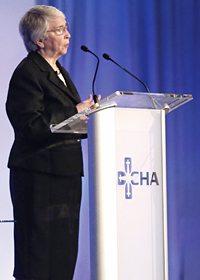By PAMELA SCHAEFFER
ANAHEIM, Calif. — Sr. Helen Amos, RSM, opened the 2013 Catholic Health Assembly on June 2 with a scene-setting keynote address, urging health care leaders to shape the future of health reform in the interest of people who could be "left behind or left out."
 "Going forward, what we should care about most is improving the situation of those for whom, through no fault of their own, the present system does not and cannot work," she said, noting that keeping that focus "would be the surest way of carrying out the assembly theme, 'Living Mission in a Changing World.'"
"Going forward, what we should care about most is improving the situation of those for whom, through no fault of their own, the present system does not and cannot work," she said, noting that keeping that focus "would be the surest way of carrying out the assembly theme, 'Living Mission in a Changing World.'"
Sr. Amos, a leader of Mercy Health Services in Baltimore for more than two decades, said her goal was "to speak simply and from my heart" to leaders of all faiths about the implications of mission in a time of "unprecedented pressure." (Photo by Michael Katada)
Headwinds
"We are endeavoring to position our organizations to continue effectively serving our communities under a sweeping new health care law and in the midst of demographic, technological and information developments of a very high order," she said, "forces that fundamentally change the very definition of a health care organization's relevance, let alone its path to success." One cause for celebration, she said, is that lay leaders are decisively at the helm, chosen and ready to carry the ministry into an uncertain future. Her goal in her talk, she said, was to offer some practical ideas, anchored in "a sense of mission," that might bring vibrancy and energy to "what is certain to be very hard work" ahead.
"Admittedly, much is unknown about what impact the system reform that is underway will have on our ministry," she said, noting that "what has been gained through the Affordable Care Act in terms of theoretical access to coverage is at best a first step" a first step, she emphasized, "toward the actual systemic change that is needed to move in the direction called for by our vision."
Healing the world
"Vision" was a key theme of Sr. Amos's talk — getting the vision right. In organizational parlance, she noted, vision is normally used by strategic planners looking forward five or 10 years. But for Catholic health care, "living mission" requires leaders to "stretch our sights, to contemplate a far, far grander vision É an extension of Jesus' own mission" — nothing short of building the kingdom of God on earth, she said.
"I hope you will not see this line of thought as a wild departure from my intention to say something you can find practical," she said. "To the contrary, the point I am trying to make is that it is precisely this ultimate vision that ought to energize our work on behalf of a better future in this world." As Catholic health care leaders, we carry out the divine intention by "our work for the poor, the sick, the lonely — anything we do to bind up and heal the wounds of the world." This grander vision, she said, "clarifies and deepens the meaning of our efforts to build credible institutions that serve the common good."
Mercy's success
Sr. Amos, executive chair of the board of trustees of Mercy Health Services and former president and chief executive of Mercy Medical Center, used the story of Mercy's success in Baltimore to illustrate how organizations can both gain credibility and position themselves for the future. The key, she said, is to attend to foundational values while addressing community needs and making services available to those who cannot pay.
Building on Mercy's historic special concern for women and children, the hospital grew from a struggling, single, acute care facility "into an entity spread over metropolitan Baltimore and its suburbs," despite competition from six hospitals, including "two medical giants: the University of Maryland Medical Center and Johns Hopkins." It did this, she said, by first creating a "center of excellence" with services focused on women's health. From there, the hospital went on to build more than a dozen additional centers of excellence downtown and to help rebuild the surrounding neighborhood. The sisters remained firmly committed to the urban location, though establishing ambulatory care sites throughout the region.
"Loyalty to the community around us has been a constant factor in all the strategic choices we have made," she said. "We are proud of the fact that more of Baltimore city's babies are born at Mercy than at any other hospital in the area," though 67 percent of the mothers are uninsured or underinsured.
Hers, she said, is a story for its time that, like other stories of its kind, holds lessons for an entirely new era focused on managing population health. "Note, a whole new vocabulary!" she exclaimed. Maintaining focus on the communities that our ministries serve "will be a necessary anchor for our ministry," as will "clarity of mission and vision" while developing new alliances and building new models of care. That clarity requires strong efforts to address "misery's systemic causes," she said, adding that focusing on "a few specifics that might be labeled 'traditional Catholic issues' would miss that crucially important point."
Before moving to health care, Sr. Amos served as a math teacher, college administrator and provincial and national leader of the Sisters of Mercy in the United States. Pope John Paul II honored her with the Pro Ecclesia et Pontifice award in 1997, and she received CHA's Sr. Concilia Moran Award in 2002. She chairs "The Journey Home, Baltimore's Ten-Year Plan to End Homelessness."
Copyright © 2013 by the Catholic Health Association
of the United States
For reprint permission, contact Betty Crosby
or call (314) 253-3477.